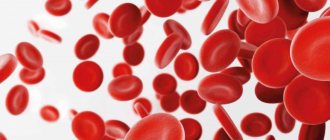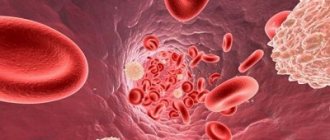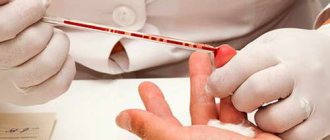Normally, there should not be a single red blood cell in the urine. Sometimes they get there due to heavy load or abuse of spices. But if there are a lot of red blood cells, this often indicates the development of a disease, including cancer. Therefore, it is recommended to consult a doctor as soon as possible and undergo all necessary examinations.
Red blood cells in urine: normal
Normally, there should be no red blood cells in the urine, even in minimal quantities. These are red cells that are found only in blood vessels. They do not pass into the bladder or ureter, and therefore should not be contained in the urine. But in isolated cases, deviation from the norm is acceptable.
Red blood cells can be found in small quantities in the urine due to the following consequences:
- strong physical activity;
- alcohol abuse;
- long period of work literally on your feet;
- certain pathologies;
- too frequent use of spices in food.
Normally, in the urine of both men and women, only 1, 2 or 3 red blood cells can be observed in the field of view. If in fact there are more of them, in many cases this indicates the development of pathology.
Preparation for the procedure
Preparation for a general urine test begins the day before the collection of biomaterial.
Certain foods, the amount of fluid you drink, taking medications and dietary supplements, and intense physical activity can distort the results of the study. The day before collecting urine, you should avoid foods that can affect the color of your urine: for example, beets and blueberries give your urine a reddish tint; consuming large amounts of carrots or carotene supplements may change the color of your urine to orange.
On the eve of urine collection, it is not recommended to drink alcohol, coffee, dietary supplements or strong tea. If possible, you should limit your intake of diuretics (diuretics). It is necessary to exclude serious physical activity, as well as visiting a bathhouse or sauna.
Women during menstruation are not recommended to donate urine for testing, since even a small amount of blood will significantly distort the test result.
You should warn your doctor about the medications you are taking, as well as about invasive examinations (for example, cystoscopy) on the eve of the test.
Method of collecting urine for general analysis
- It is necessary to prepare in advance a disposable sterile container for collecting urine (can be purchased at a pharmacy or taken from the INVITRO medical office).
- Before collecting urine, hygienic treatment of the external genitalia should be carried out, without using antibacterial and disinfectants.
For children, you need to adhere to the following rules: girls are washed from front to back (from the pubis to the tailbone) so that bacteria that populate the intestines do not enter the urinary tract. Only wash the skin with soap, since contact with mucous membranes causes irritation, dryness and itching. In boys, the glans penis is fused with the foreskin (physiological phimosis), so it is not recommended to forcefully open the glans penis, as this leads to trauma to the delicate tissue. You just need to slightly pull the skin and rinse with water, but it is unacceptable to direct a stream of water into the opening of the urethra. - For general analysis, as a rule, the first morning urine sample is collected. First, release a small amount of urine into the toilet, then, without interrupting urination, place a container and collect approximately 50 ml of urine. In this case, it is necessary to ensure that the container does not touch the skin and mucous membranes.
- After collecting urine, close the container tightly with a screw cap.
- Special urinals have been developed for newborns and infants. You should not use urine squeezed out of a diaper or diaper - the results will be unreliable, since the diaper is a kind of filter for microscopic elements of urine, which are counted during the study.
- When taking the test during the day, it is not recommended to drink large amounts of water, tea, coffee or diuretics to stimulate urination.
The turnaround time for a general urine test is usually 1 business day.
How is an increased content of red blood cells in urine determined?
The analysis consists of 2 stages:
- Studying the color - if the urine has a brown, reddish tint, this indicates a repeated violation of the norm.
- Microscopic examination - if there are more than 3 red blood cells in the urine, doctors diagnose microhematuria.
When establishing an accurate diagnosis, doctors determine the type of red blood cells:
- Unchanged - they contain hemoglobin, and are found in the urine in exactly the same form as in the bloodstream.
- Modified - alkaline. They do not contain hemoglobin, and the cells lose their red color and become colorless. They look like rings (normally they should look like disks with a biconcave surface).
If blood elements are found in the urine, this clearly indicates a pathological process, and it can be very dangerous. Therefore, you must immediately consult a doctor for further examination and consultation.
When should women undergo a general urine test?
You can take a urine test on the recommendation of your doctor or on your own for the following reasons:
- Preventive annual health examination
- Before any planned hospitalization
- If there are complaints from the urinary system (pain and cramps when urinating, pain in the lumbar region, change in the color and smell of urine, frequent urination, etc.)
- Taking nephrotoxic drugs
- If you are sick and pathological changes were detected in the first urine test
Why are red blood cells in urine elevated?
The reasons for the appearance of blood cells in the urine can be very different. For convenience, they are divided into 3 groups:
- Somatic (prerenal) - they are associated not with the excretory system, but with other organ systems.
- Renal – occur against the background of kidney pathologies.
- Postrenal – associated specifically with the excretory system.
If we talk in more detail about the somatic group, we can highlight the following reasons:
- Thrombocytopenia is a decrease in the concentration of platelets in the bloodstream. This leads to blood clotting disorders, which causes red blood cells to end up in the urine.
- Hemophilia is a deterioration in blood clotting, due to which it thins out and also penetrates into the urine.
- Poisoning of the body, for example, due to a bacterial or viral infection.
The main reasons of a renal nature:
- Glomerulonephritis of acute or chronic nature.
- Kidney cancer - the tumor increases in size and destroys the wall of the vessel.
- Urolithiasis – due to stones, the mucous membrane is destroyed.
- Pyelonephritis - inflammation leads to impaired permeability of the blood vessels of the kidneys.
- Hydronephrosis - poor urine flow leads to damage to the walls of blood vessels.
Postrenal causes:
- Cystitis is an inflammatory process in the bladder that causes blood cells to leak into the urine.
- A stone in the ureter, bladder and, as a result, damage to the mucous membrane.
- Bladder cancer damages the walls of blood vessels.
Separately, gender-related reasons can be identified. Thus, in men, pathology is often observed against the background of:
- Prostatitis is an inflammatory process that affects the tissue of the prostate gland. It leads to the entry of red cells into the urine in large quantities, which clearly indicates pathology.
- Prostate cancer – a tumor appears that increases in size and begins to put pressure on the walls of blood vessels. They receive damage through which cells leak.
In women, the cause may be:
- Uterine bleeding - sometimes as a result of injuries, blood from the vagina enters the urine directly when visiting the toilet.
- Cervical erosion - a wound appears on the uterine mucosa, often due to traumatic exposure, sexually transmitted infections or hormonal imbalance. As a result, secretions are released, including those mixed with blood, which ends up in the urine.
How to detect hematuria?
Visible hematuria often bothers patients and forces them to see a doctor.
Microhematuria is determined by microscopy of urine sediment.
What tests are needed to make a diagnosis?
Any patient with gross hematuria or significant microhematuria should undergo a comprehensive evaluation of the urinary tract. The first step is a thorough history and physical examination. Next, a laboratory urine test and examination of the urinary sediment under a microscope are performed. The urine is tested for protein (a sign of kidney disease) and urinary tract infections. The number of red blood cells in the urine (erythrocyturia) and the content of leukocytes in the urine (leukocyturia) are determined. A urine cytology test is needed to check for abnormal cells. Laboratory blood tests are performed to measure serum creatinine levels (kidney function tests).
Patients with significant protein in the urine or elevated creatinine levels should undergo additional testing to rule out kidney disease.
A complete urologic examination in patients with hematuria also includes x-rays of the kidneys, ureters, and bladder (an overview of the urinary system) to rule out masses and stones. Excretory urography is performed - a method for determining kidney function, based on the introduction of radiopaque agents into the bloodstream, followed by radiography and determination of the release of dye by the kidneys.
Many doctors may choose other imaging tests, such as computed tomography (CT) or multislice computed tomography (MSCT). These methods are preferred and more informative for assessing the condition of the kidneys, and are also the best methods for assessing urinary stones. Recently, many urologists have been using CT urography. This allows the urologist to look at the kidneys and evaluate the condition of the ureters as a result of a single x-ray. In patients with elevated creatinine levels or allergies to radiocontrast agents, magnetic resonance imaging (MRI) or retrograde pyelography is performed to evaluate the upper urinary tract. During retrograde pyelography, the patient is taken to the operating room, a radiopaque contrast agent is injected into the kidney through a ureteral catheter, followed by radiography.
Patients with hematuria undergo cystoscopy under local anesthesia using a rigid, or more often, flexible instrument - a cystoscope. After anesthesia, a cystoscope is inserted through the urethra into the bladder and the bladder and urethra are assessed for the presence of masses.
What to do if there was or is hematuria, but no cause was found as a result of the examination?
In at least 8-10 percent of cases, no cause for hematuria is found. Some studies have shown an even higher percentage of patients without a cause. Unfortunately, we have to admit that the same studies later showed that 3 percent of patients were later diagnosed with malignant tumors of the urinary system.
Thus, there is a risk of underexamining the patient or failing to determine the initial stages of some formations. There are no recommendations for subsequent comprehensive examination. Also, there is still no consensus among urologists on this topic.
It is still recommended to consider repeating urine and cytology tests at 6, 12, 24 and 36 months. In the case of repeated gross hematuria, a positive result of urine cytology, or the appearance of irritating urinary symptoms such as pain during urination or frequent urination, an immediate reassessment of the condition of the urinary system is carried out with cystoscopy and repeated radiological diagnostic methods. If none of these symptoms are detected within three years, no further urological examination is required.
Cases of complications
Sometimes not only red blood cells are found in the urine, but also other blood cells - leukocytes, as well as protein compounds. This is clearly a pathological condition, which indicates the development of pathogenic processes. As a rule, they are associated with the following reasons:
- hemorrhagic cystitis;
- urolithiasis;
- inflammation in the kidneys;
- tuberculosis;
- tumors of various nature in the urinary tract.
It is important to take action immediately and get tested. Otherwise, kidney pathology can become chronic, resulting in renal failure.
Isolated microhematuria
Isolated microhematuria is a difficult condition to interpret, but is often discovered by chance during a regular preventive medical examination.
In this case, microhematuria can be repeated in each subsequent urine test of the patient (persistent), or disappear periodically (intermittent). In itself, such division of hematuria does not allow us to determine the localization of the pathological focus.
It is more informative to divide microhematuria into symptomatic and asymptomatic (that is, hematuria accompanied by symptoms and without any manifestations).
Criteria for isolated hematuria:
- 1 Urine red blood cells 3-5 in the subcutaneous region, without change in urine color in 2 consecutive urine tests;
- 2 Absence of any complaints from the patient;
- 3 Absence of obvious signs of somatic pathology;
- 4Proteinuria is absent or trace (the amount of protein in the urine ranges from 0.033-0.066 g/l).
Decoding the indicators of general urine analysis in adults
Treatment
Treatment is always prescribed by a doctor. To begin with, treat the symptom of bloody discharge in the urine.
If the cause is hidden in internal bleeding, then the patient is usually prescribed hemostatic drugs. You should not delay the appearance of a high content of red blood cells, leukocytes and other elements and substances foreign to the composition of urine. It is also necessary to pay attention to the color of the urine.
Doctors warn that later treatment will be ineffective and sometimes even useless. An example of the transformation of a disease such as prostatitis into an oncological tumor should make men think about their male health.
When a diagnosis has been completed by a specialist and a pathology has been identified, the treatment process should begin immediately. After all, later treatment may not be necessary if the patient develops complications. Only surgery can help a sick man in such cases.
Establishing diagnosis
The number of red cells in urine can only be calculated through laboratory tests. A person notices changes in the color of urine when there is blood in it. The low blood content in urine explains its brownish tint. Blood lumps on underwear indicate cancer.
Kidney bleeding is diagnosed when the urine is scarlet in color. The diagnosis of hematuria is made when a burning sensation is added to the color of the urine. And hematuria, in turn, is caused by urolithiasis or infection.
An increase in red blood cells in the urine is often associated with a male disease - prostatitis. A pronounced symptom is a constant desire to go to the toilet, while the discharge will be scanty in quantity.
Modern research methods help to identify a specific diagnosis of a pathological condition: ultrasound, blood tests.
Causes of High Red Blood Cell Count
Red blood cells increase in a woman’s body in response to many diseases; for convenience, the reasons are divided according to the level of damage:
- Renal - an increase in red blood cells may indicate damage to the kidney tissue in a woman.
- The content of red blood cells in excreted urine increases as a result of postrenal causes, and the urinary organs suffer.
- Somatic factors: an increase in red blood cells is an indirect sign of a disease not related to the kidneys.








